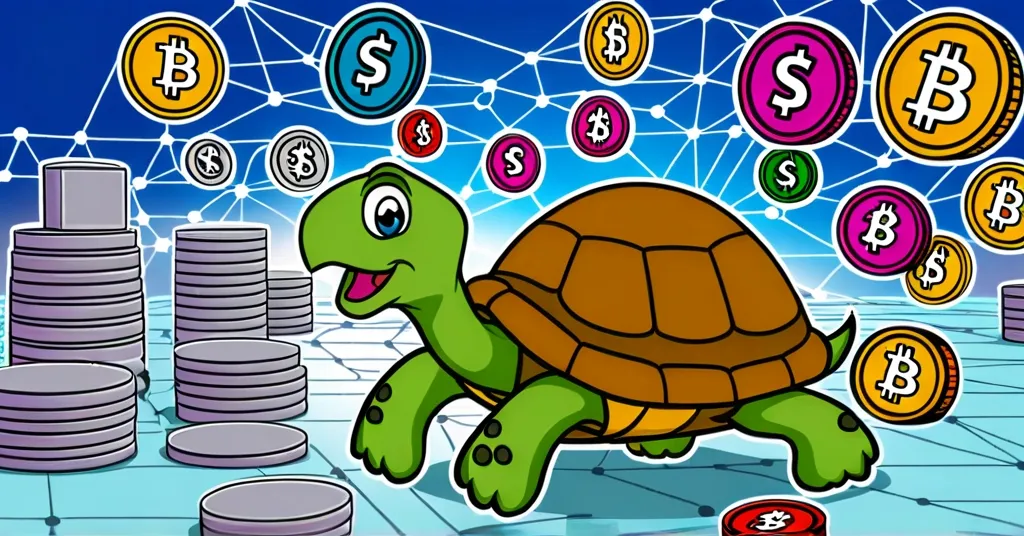Turtle Club: Pioneering Web3 Rewards Amid DeFi Innovations by Gnosis and Chorus1

Turtle Club: Revolutionizing Web3 User Rewards and the DeFi Landscape
Turtle Club, spearheaded by Esfandiar Lagevardi, is making waves in Web3 by enabling users to earn rewards from their on-chain activities. This initiative, combined with recent developments from Gnosis and Chorus1, is reshaping the DeFi landscape.
- Turtle Club: First distribution protocol in Web3
- Governance tokens: Key to user engagement
- DeFi vs. TradFi: Contrasting financial models
- Challenges: Yield sustainability and privacy
- Innovations: Gnosis Pay and Chorus1 OPUS
Introduction to Turtle Club
Turtle Club stands out as the pioneering distribution protocol in Web3, crafted to empower users to maximize their earnings from on-chain activities. These activities, or actions taken using blockchain technology, not only incentivize participation but also play a crucial role in bootstrapping new projects—helping them get off the ground and grow. Esfandiar Lagevardi, the visionary behind Turtle Club, emphasizes its mission, stating:
“Turtle Club built the first distribution protocol of Web3, helping its users maximize their rewards they get for meaningful on-chain activities that help bootstrap projects.”
Turtle Club’s approach is akin to a decentralized farmers’ market, where users can trade and earn rewards based on their contributions, contrasting with the centralized supermarket chain model of traditional finance (TradFi). Through user testimonials, we’ve seen how individuals like Sarah, an early adopter, have significantly benefited from the platform, turning their on-chain participation into tangible rewards.
Governance Tokens in Web3
Web3 projects are increasingly leveraging governance tokens to engage and retain users. These tokens serve as a direct incentive for users to participate in activities that drive project development and revenue generation. Imagine governance tokens as the VIP passes to a project’s decision-making process, giving holders a say and a stake in its future. Projects like Uniswap and Compound have successfully utilized this model, fostering a community-driven approach to innovation.
DeFi vs. TradFi
The decentralized nature of DeFi offers a stark contrast to the centralized control of TradFi. While DeFi can be likened to a decentralized farmers’ market, where anyone can participate and innovate, TradFi resembles a supermarket chain with set rules and regulations. DeFi’s promise lies in its accessibility and potential for innovation, though it still faces hurdles in widespread adoption and acceptance.
The key differences between these financial models include risk assessment, where DeFi often relies on smart contracts and on-chain data, while TradFi depends on traditional credit scoring and regulatory oversight. For users, this means a shift from centralized authority to a more democratic, albeit riskier, financial ecosystem.
Challenges in DeFi
Despite its growth, DeFi faces significant challenges. Yield sustainability remains a concern, as the high returns that initially attracted users may not be sustainable long-term. Risk quantification is another hurdle, as the decentralized nature of DeFi makes it difficult to assess and manage risks accurately.
Moreover, the ongoing debate over on-chain transparency versus privacy continues to be a contentious issue. While transparency is fundamental to blockchain technology, it can sometimes conflict with user privacy, posing security risks and regulatory challenges.
Recent Innovations
The launch of Gnosis Pay by Gnosis marks a significant step forward in the Ethereum ecosystem. As the world’s first Decentralized Payment Network, Gnosis Pay aims to bridge the gap between digital assets and everyday financial transactions. This initiative aligns with the vision of a decentralized internet, as outlined in Bitcoin’s whitepaper, promoting permissionless innovation and open infrastructure.
Meanwhile, Chorus1’s introduction of OPUS, allowing staking of up to 8,000 ETH in a single transaction, exemplifies the ongoing advancements in staking solutions. Supporting over 100,000 delegators across 45 networks, Chorus1 is enhancing the Ethereum ecosystem’s resilience and promoting credible neutrality through solo staking on the Gnosis Chain.
Critical Analysis and Counterpoints
While Turtle Club and other DeFi innovations hold promise, they are not without potential downsides. Critics argue that the reliance on governance tokens could lead to token inflation and decreased value over time. Additionally, the sustainability of reward systems like Turtle Club is questioned, as the long-term viability of incentivizing on-chain activities remains uncertain.
Expert opinions vary, with some praising the democratization of finance through DeFi, while others caution about the risks associated with its decentralized nature. Community feedback often highlights the need for better risk management and more robust privacy protections to ensure the sector’s growth and longevity.
Future Outlook
Looking ahead, the integration of DeFi with TradFi through innovations like Gnosis Pay could herald a new era of financial inclusion and innovation. However, regulatory considerations will play a crucial role in shaping the path forward. As the DeFi landscape continues to evolve, projects like Turtle Club will need to navigate these challenges while continuing to drive user engagement and project development.
In this fast-paced world of crypto, the future is bright for those who embrace the principles of decentralization, freedom, and privacy. Yet, we must remain vigilant, questioning the sustainability of current models and advocating for solutions that truly benefit the community.
Key Questions and Takeaways
- What is Turtle Club? Turtle Club is a platform within Web3 that enables users to maximize rewards from their on-chain activities, aiding in the bootstrapping of projects.
- How do Web3 projects incentivize user participation? Web3 projects use governance tokens to directly incentivize users to engage in activities that support project development and revenue generation.
- What are the main differences between DeFi and TradFi? DeFi offers decentralized financial services with different risk models and user incentives compared to traditional finance, which is often centralized and regulated.
- What challenges does DeFi face? Challenges in DeFi include yield sustainability, risk quantification, adoption barriers, and balancing on-chain transparency with privacy.
- What recent developments were mentioned from Gnosis and Chorus1? Gnosis launched Gnosis Pay, the world’s first Decentralized Payment Network, and Chorus1 introduced OPUS, allowing staking up to 8,000 ETH in a single transaction.



